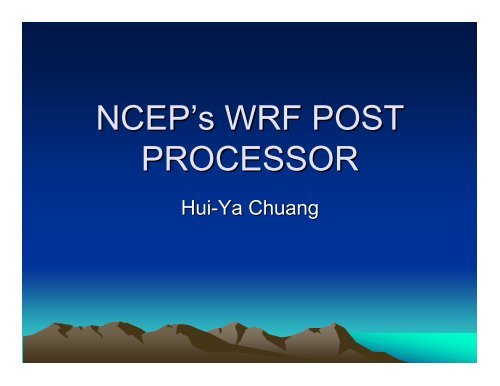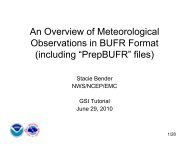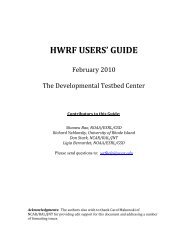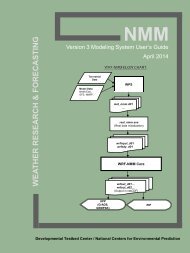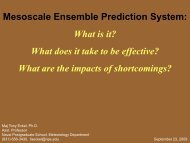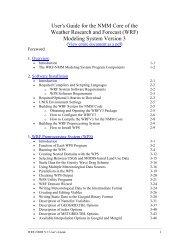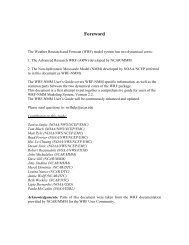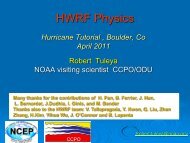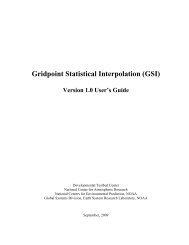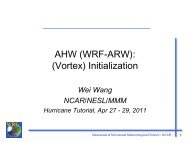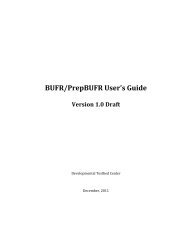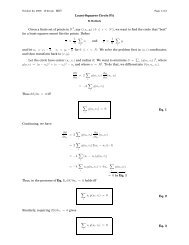NCEP's WRF POST PROCESSOR
NCEP's WRF POST PROCESSOR
NCEP's WRF POST PROCESSOR
You also want an ePaper? Increase the reach of your titles
YUMPU automatically turns print PDFs into web optimized ePapers that Google loves.
NCEP’s <strong>WRF</strong> <strong>POST</strong><br />
<strong>PROCESSOR</strong><br />
Hui-Ya Chuang
Outline<br />
• Overview<br />
• Sample fields generated by <strong>WRF</strong> post package<br />
• Derivation of commonly used fields<br />
• Break<br />
• Installation<br />
• Controlling what to output<br />
• Visualization
Introduction I<br />
• NCEP’s <strong>WRF</strong> post processor can post process<br />
model output from <strong>WRF</strong> NMM and <strong>WRF</strong> ARW.<br />
• NCEP uses <strong>WRF</strong> post processor as the<br />
common post processor so that forecasts from<br />
different models can be compared and verified<br />
fairly.
Introduction II - IO<br />
• <strong>WRF</strong> post reads in model output in either binary<br />
or netcdf format using <strong>WRF</strong> IO API.<br />
• Users are encouraged to use netcdf format.<br />
NCEP uses binary output for speed.<br />
• Output is on NCEP standard or user-defined<br />
grids in NWS & WMO standard GRIB format,<br />
which can be read by GEMPAK and GrADS.
Introduction III – Platform portability<br />
• <strong>WRF</strong> post has been developed on NCEP’s IBM<br />
with MPI application.<br />
• <strong>WRF</strong> post was also ported to run on linux thanks<br />
to Bob Rozumalski, Ligia Bernardet, Dusan<br />
Jovic and Meral Demirtas.
Introduction IV – Different components<br />
of <strong>WRF</strong> post package<br />
• Two components of <strong>WRF</strong> post package:<br />
1) wrfpost: a) perform vertical interpolations<br />
onto pressure and other levels (parallized for<br />
3D computation), b) compute diagnostic fields,<br />
c) horizontally interpolate velocity onto mass<br />
points for ARW only;<br />
2) copygb: performs horizontal interpolations<br />
and de-staggering. Note that most graphics<br />
packages can not handle staggered grids.
Introduction IV – Different components<br />
of <strong>WRF</strong> post package - Continued<br />
• Computational domain of <strong>WRF</strong> NMM is on<br />
Arakawa-E rotated lat/lon, so copygb utility is<br />
needed to convert model output onto nonstaggered<br />
grid.<br />
• Computational domain of <strong>WRF</strong> ARW is on<br />
Arakawa-C grid. However, because wrfpost<br />
interpolates all velocity fields onto mass points<br />
for ARW and hence convert model output onto<br />
an A grid, no further horizontal interpolations<br />
are needed (i.e., no need to run copygb).
Fields generated by <strong>WRF</strong> post package<br />
• <strong>WRF</strong> post package currently outputs 288 fields.<br />
Complete list can be found in Table 1 of your user<br />
guide or online:<br />
http://wwwt.emc.ncep.noaa.gov/mmb/papers/chuang/2/wrfpost.txt<br />
• Sample fields generated by <strong>WRF</strong> post package:<br />
1) Temperature, height, humidity, 3D wind, cloud<br />
water, cloud ice, rain, and snow on 47 isobaric levels<br />
(8 levels above 75 mb and then from 75 to 1000 mb<br />
every 25 mb);<br />
2) Shelter level temperature, humidity, and wind fields;
Fields generated by <strong>WRF</strong> post package<br />
3) SLP (two types);<br />
- Continued<br />
4) Precipitation related fields:<br />
a) Accumulated and instantaneous precipitation for<br />
total, convective, and grid scale,<br />
b) Radar reflectivity, visibility, and precip types;<br />
5) PBL related fields: PBL height, 6 layers of PBL 30<br />
mb layer-averaged temperature, humidity, and wind;<br />
6) Diagnostic fields: Vorticity and geostrophic stream<br />
function;
Fields generated by <strong>WRF</strong> post package<br />
- Continued<br />
7) Radiation related fields: instantaneous and timeaveraged<br />
surface fluxes for sensible, latent, ground,<br />
downward and upward shortwave and longwave;<br />
8) Cloud related fields:<br />
a) Cloud fraction,<br />
b) Cloud top/bottom pressure, height, and<br />
temperature for total, convective, and grid-scale;<br />
9) Aviation products: in-flight icing and ceiling;
Computation of atmospheric isobaric fields<br />
• Vertical interpolation of all state fields from<br />
model to pressure levels is performed in linear<br />
in ln(p) fashion.<br />
• <strong>WRF</strong> NMM model does not output height<br />
fields, so the <strong>WRF</strong> post processor derives<br />
<strong>WRF</strong> NMM model level heights by integrating<br />
virtual temperature hydrostatically from bottom<br />
up.
Computation of underground isobaric fields<br />
• Underground vertical and horizontal wind<br />
components are specified to be the same as those<br />
at the first atmospheric model layer above ground.<br />
• Underground temperature is reduced by assuming<br />
constant virtual potential temperature from the<br />
temperature averaged over the second and the<br />
third model levels above the surface.<br />
• Underground humidity fields are computed so as<br />
to maintain RH averaged over the second and<br />
third model levels from the ground.
Derivation of sea level pressure type I:<br />
standard NCEP SLP<br />
• Ground and sea level temperatures are extrapolated<br />
from the temperature at the lowest atmospheric layer<br />
by assuming a constant lapse rate of 6.5 K/KM.<br />
• Compute τ = R d<br />
T v<br />
/ g at ground and sea level and then<br />
apply Shuell correction to both τs. The basic principal<br />
of Shuell correction is to make sure that τs at both sea<br />
level and ground do not exceed a critical value.<br />
• Standard NCEP SLP is then derived as follows:<br />
2 × HSFC<br />
SLP = PSFC × exp(<br />
)<br />
τ ( SFC)<br />
+τ ( SLP)
Derivation of sea level pressure type II:<br />
membrane NCEP SLP<br />
• Re-compute underground virtual temperatures by<br />
horizontally relaxing virtual temperatures on<br />
pressure levels:<br />
∇<br />
2<br />
T<br />
v<br />
=<br />
• The nine-point successive over-relaxation formula is<br />
used to solve the above Laplace’s Eq. numerically.<br />
• Once all underground virtual temperatures are<br />
generated, the hydrostatic equation is integrated<br />
downward to obtain sea level pressure.<br />
0.
Computation of simulated radar<br />
reflectivity<br />
• Two algorithms are used to compute simulated<br />
radar reflectivity depending on the microphysics<br />
(MP) option used in the model run:<br />
1) Ferrier MP scheme: derived by Ferrier to be<br />
consistent with assumptions made in Ferrier MP<br />
scheme. A maximum of 80 dBZ and a minimum of<br />
-20 dBZ are applied. More information can be found<br />
in Ferrier’s 94 JAS publication;<br />
2) Other MP schemes: adopted from RIP4. More<br />
information can be found online:<br />
http://www.mmm.ucar.edu/wrf/users/docs/ripug.htm
Computation of simulated radar<br />
reflectivity (Cont)<br />
• If users wish to use RIP4 radar reflectivity<br />
algorithm to derive radar reflectivity for Ferrier<br />
scheme for fair comparisons, please email me.<br />
• The next release of <strong>WRF</strong> post will likely have<br />
two distinctive Grib ID for the two algorithms.
Shelter level fields and PBL height<br />
• Shelter level fields and PBL height are direct<br />
output from <strong>WRF</strong> model, not interpolated or<br />
diagnosed in the <strong>WRF</strong> post.<br />
• This ensures that these fields are derived within<br />
the model based on surface and PBL physics<br />
consistent with your model runs.
Computation of other fields<br />
• Computation of many other fields can be found in ETA<br />
post documentation online:<br />
http://www.emc.ncep.noaa.gov/mmb/papers/chuang/1/OF438.html<br />
• Note that there are some differences between <strong>WRF</strong> and<br />
ETA post when looking through documentation. Two<br />
major differences are differences in 1) vertical coordinate<br />
and in 2) how to ingest constants used by model. One<br />
example is that <strong>WRF</strong> post no longer reads in namelist<br />
FCSTDATA.<br />
• Eta post documentation will soon be updated to become<br />
<strong>WRF</strong> post documentation.
Download<br />
• The tar file wrfpost_v2.2.tar containing all the source code,<br />
scripts, and libraries is available via DTC site:<br />
http://www.dtcenter.org/wrf-nmm/users/downloads<br />
• Un-tarring the tar file creates 4 directories, a configure file,<br />
and two master makefiles for two supported platforms:<br />
1) sorc/: source code;<br />
2) scripts/: sample scripts for running post and graphics<br />
packages;<br />
3) lib/: libraries used by wrfpost and copygb;<br />
4) parm/: control files used by wrfpost;<br />
5) configure: to set up proper makefiles based on user’s<br />
platform and path names for IO libs;<br />
6) makefile: master makefile to compile all the lib and sorc.
Installation I – Compile source codes<br />
• Configure your makefiles by executing the file<br />
configure. Users will be prompted to specify:<br />
1) platform: enter “1” for LINUX or “2” for IBM;<br />
2) path name of your netcdf utility;<br />
3) path name of your <strong>WRF</strong> model source code.<br />
• Compile all the libraries and source codes by<br />
executing the master makefile in the top<br />
directory.
Installation II – Run wrfpost<br />
• wrfpost needs three input files:<br />
1) itag: read in via unit 5 to provide information on<br />
a) model output file name in first line,<br />
b) format of model output in second line (netcdf<br />
or binary),<br />
c) forecast verifying time in <strong>WRF</strong> format in third line,<br />
d) model name in fourth line (NMM or NCAR);<br />
2) wrf_cntrl.parm: control file to let users specify which<br />
fields to output;<br />
3) eta_micro_lookup.dat: look-up table containing MP<br />
coefficients used by Ferrier scheme.
Installation II – Run wrfpost – Sample<br />
script run_wrfpost<br />
#!/bin/sh<br />
set -aeux<br />
export tmmark=tm00<br />
cat > itag
Installation III – Description of wrfpost<br />
control file wrf_cntrl.parm<br />
specifying grid number<br />
KGTYPE******I5*******:(00255)********START OF THIS OUTPUT<br />
IMDLTY *I5* :(00089)<br />
DATSET *A6* :(<strong>WRF</strong>PRS) GRIB packing precision<br />
(PRESS ON MDL SFCS ) SCAL=( 3.0)<br />
L=(11000 00000 00000 00000 00000 00000 00000 00000 00000<br />
(HEIGHT ON MDL SFCS ) SCAL=(-5.0)<br />
L=(11000 00000 00000 00000 00000 00000 00000 00000 00000<br />
switch to specify which level of field to output with “1” being yes<br />
abbreviated name used in post source code for each field
Installation IV – Use wrfpost control file<br />
to output a field<br />
• To output a desired field:<br />
1) Look through field names in Table 1 of <strong>WRF</strong><br />
post user guide to see if <strong>WRF</strong> post produces this<br />
field;<br />
2) If yes, note the corresponding abbreviated<br />
name in the 2 nd column of the Table 1 and look<br />
for it in wrf_cntrl.parm; the control file supplied in<br />
the tar file listed all available fields;<br />
3) Make sure that the switch is turned onto “1”;
Installation V – Use wrfpost control file<br />
to output fields on multiple levels<br />
• wrfpost outputs fields on many different types of<br />
vertical coordinates:<br />
1) native model vertical levels;<br />
2) 47 pressure levels: 2, 5, 7, 10, 20, 30, 50, 70 mb,<br />
then 75 to 1000 mb every 25 mb;<br />
3) 7 flight levels above MSL: 914,1524,1829,2134,<br />
2743, 3658, 6000;<br />
4) 6 layers of 30 mb averaged PBL layers;<br />
5) 2 AGL level: 1000 and 4000 m for radar reflectivity.<br />
• Except for AGL and pressure levels, all the other<br />
vertical levels are counted from bottom to top in<br />
wrf_cntrl.parm.
Installation V – Use wrfpost control file<br />
to output fields on multiple levels - Cont<br />
• To output temperature fields at 75 and 125 mb:<br />
(TEMP ON PRESS SFCS ) SCAL=( 3.0)<br />
L=(00000 00010 10000 00000 00000 00000 00000 00000 00000<br />
• To output 30 mb PBL mean U from 30 to 60 mb<br />
and then from 90 to 120 mb AGL:<br />
(U WIND IN BNDRY LYR ) SCAL=( 3.0)<br />
L=(01010 00000 00000 00000 00000 00000 00000 00000 00000
Installation VI – run copygb<br />
• To use copygb to perform horizontal interpolations:<br />
copygb –xg”${grid}” in.grb out.grb<br />
Two ways to specify ${grid} :<br />
1) Use NCEP standard grid number by specifying<br />
${grid} = NCEP standard grid number<br />
To interpolate your Grib file onto NCEP grid 212:<br />
copygb –xg212 in.grb out.grb<br />
To find a NCEP standard grid that matches your output domain,<br />
look up the grid specs for all NCEP grids online:<br />
http://www.nco.ncep.noaa.gov/pmb/docs/on388/tableb.html
Installation VI – run copygb - Continued<br />
2) Use user-defined grid navigation by specifying<br />
${grid} = ‘255 INT(18)’<br />
To interpolate your Grib file onto a Lambert Conformal grid:<br />
copygb –xg”255 3 IM JM STARTLAT STARTLON 8 CENLON DX DY 0<br />
64 TRUELAT1 TRUELAT2 ” in.grb out.grb<br />
, where STARTLAT/LON are LAT/LON of lower left corner in 1000<br />
degree, CENLON is the parallel meridian in 1000 degree, DX/DY<br />
are grid resolutions in 1000 km, TRUELAT1 and 2 are intersecting<br />
LAT.
Installation VI – run copygb - Continued<br />
• Running wrfpost produces two ascii files containing<br />
grid navigation information that can be used by<br />
copygb:<br />
1) copygb_gridnav.txt for Lamber Conformal grid<br />
2) copygb_hwrf.txt for Lat/LON grid<br />
• The sample scripts run_wrfpostandgempak and<br />
run_wrfpostandgrads show examples on how to use<br />
copygb and the above two text files to horizontally<br />
interpolate onto a user-defined grid.<br />
• More instructions on how to run copygb can be<br />
found in the file copygb.doc that comes with the<br />
copygb source code.
GRIB file visualization with GEMPAK<br />
• GEMPAK has an utility named “nagrib” that reads<br />
GRIB files on any non-staggered grids and then<br />
generates GEMPAK-binary files that are readable by<br />
all GEMPAK programs<br />
• GEMPAK can plot horizontal contours, cross-sections,<br />
meteograms, and sounding profiles.<br />
• Package download and user guide are available<br />
online:<br />
http://my.unidata.ucar.edu/content/software/gempak/index.html<br />
• A sample script named run_wrfpostandgempak is<br />
included in scripts/ that can be used to run wrfpost,<br />
copygb, and then plot various fields using GEMPAK.
Sample script run_wrfpostandgempak<br />
nagrib
<strong>WRF</strong> NMM forecast plotted with GEMPAK :<br />
Precipitation and derived Radar reflectivity
GRIB file visualization with GrADS<br />
• GrADS also has utilities to read GRIB files on any nonstaggered<br />
grids and then generates GrADS control<br />
files. The utilities grib2ctl and gribmap are available via<br />
Wesley Ebisuzaki’s web site:<br />
http://www.cpc.ncep.noaa.gov/products/wesley/grib2ctl.html<br />
• Package download and user guide for GrADS are<br />
available online:<br />
http://grads.iges.org/grads/gadoc/<br />
• A sample script named run_wrfpostandgrads is<br />
included in scripts/ that can be used to run post,<br />
copygb, and then plot various fields using GrADS.
Sample script run_wrfpostandgrads<br />
grib2ctl.pl -verf wrfnmm${fhr}.tm00 > wrfnmm${fhr}.ctl<br />
ctrl file<br />
gribmap -i wrfnmm${fhr}.ctl<br />
create<br />
create index file<br />
cat > plotgrads
<strong>WRF</strong> NMM forecast plotted with GrADS:<br />
Precipitation and derived Radar reflectivity
<strong>WRF</strong> NMM and ARW fields ingested by<br />
<strong>WRF</strong> post<br />
• A list of fields (as named in Registry file) that are read<br />
in by <strong>WRF</strong> post for both <strong>WRF</strong> NMM and <strong>WRF</strong> ARW<br />
can be found in tables 2 and 3 in your user guide or<br />
online:<br />
http://wwwt.emc.ncep.noaa.gov/mmb/papers/chuang/2/wrfpost.txt<br />
• It is important to make sure that users have all these<br />
fields in the model output so that <strong>WRF</strong> post can<br />
compute and output each field properly.<br />
• To have these fields in your model output, users will<br />
need to modify Registry file and then re-compile <strong>WRF</strong><br />
model source code. Dave Gill will talk about how to<br />
modify Registry file.
Some tips and suggestions<br />
• To reduce the size of the GRIB file, users can<br />
modify the control file wrf_cntrl.parm as<br />
mentioned earlier to only output desired fields.<br />
• If a field in your GRIB file does not have physical<br />
values, it is likely that you don’t have required<br />
fields in your model output. For example, if your<br />
vorticity fields look unreasonable, you may not<br />
have velocity or grid resolution fields in your<br />
model output.
Future plan<br />
• <strong>WRF</strong> post processor is constantly updated to add<br />
more fields and to make bug fixes. NCEP and DTC<br />
will work together to distribute the new version to<br />
users ASAP.<br />
• The planned upgrade for the <strong>WRF</strong> post processor:<br />
1) Incorporate the community radiative transfer model<br />
to more accurately simulate model derived brightness<br />
temperature for different instruments and channels<br />
such as GOES IR and water vapor channels;<br />
2) Include IO for GFS to achieve the goal of having an<br />
unified post processor at EMC;<br />
3) Convert all code to Fortran 90/95.
Observed (L) and model derived (R) brightness<br />
temperature for GOES water vapor channel
How to change the number or values of<br />
output pressure levels<br />
• Modify specification of variable LSM in the file<br />
CTLBLK.comm to change the number of<br />
pressure levels:<br />
PARAMETER (LSM=47)<br />
• Modify specification of SPL array in the<br />
subroutine <strong>POST</strong>DATA.f to change the values of<br />
pressure levels:<br />
DATA SPL/200.,500.,700.,1000.,2000.,3000.<br />
&,5000.,7000.,7500.,10000.,12500.,15000.,17500.<br />
,20000.


